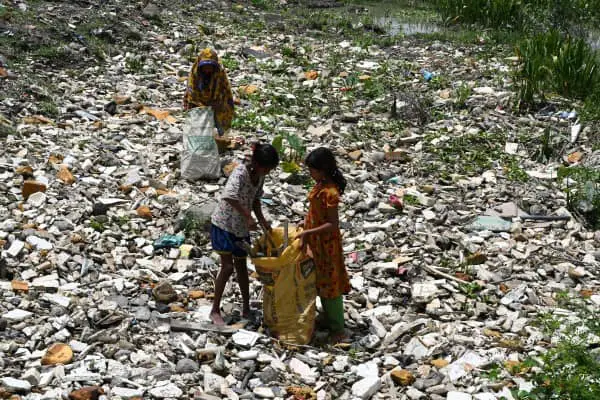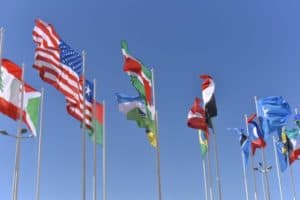Each year, billions of dollars are spent in foreign aid aiming to lift people of out poverty. There has been some success, with nearly a billion less people living on less than $1.90 a day today than did in 1990. However, with over 690 million people still living in poverty around the world, we need to ask, what role does international aid play in helping these people? And how does foreign aid actually reduce poverty?
Foreign Aid Increases Economic Growth
The first way that foreign aid reduces poverty is by increasing economic growth. It is generally agreed that countries that receive international aid benefit from a boost to their economies. Growth in the economy directly results in a reduction in poverty as people become better off as the country develops.
The role international aid plays in the economic growth of developing countries is evident in the large economic gain’s recipient countries report. For example, Ethiopia, Pakistan, and Myanmar are some of the largest recipients of foreign aid. In 2018, Ethiopia’s economy grew by 7.3%, Pakistan’s by 5.7% and Myanmar’s by 6.98%. Countries like this that receive significant amounts of foreign aid see huge economic growth and, and as a result, a reduction in poverty.
There are two main ways that foreign aid can propel economic growth and reduce poverty.
The first is increasing the revenue for developing country governments. This gives them more funds to spend on poverty reduction programmes, as well as on key areas such as infrastructure, health and education that also directly result in lifting people out of poverty.
The second way that international aid results in economic growth is by developing the private sector. Many foreign aid initiatives aim to help businesses in poorer countries grow, which in-turn results in a larger economy. As the economies of poorer countries expand, poverty is reduced, and foreign aid is vital in achieving this.
It Helps Develop More and Better Education
The second way that foreign aid reduces poverty is by increasing access to and the quality of education. Education is one of the most important ways for people and communities to lift themselves out of poverty. International aid has played a vital role in improving education in developing countries and this has resulted in a significant decrease in poverty.
Education is crucial to poverty reduction. As children get better schooling, their life prospects improve. They are better able to enter the work force, provide for themselves and their families, look after their health and make wiser economic decisions. Millions in foreign aid spending are directed towards education projects exactly because it is so important in reducing poverty.
Over the past two decades millions more children have gained access education. International aid has been crucial to achieving this. As a result of more children receiving schooling, poverty rates have fallen.
Many developing countries lack the resources to provide quality education to their young populations. This is a big reason for widespread poverty in many poorer nations. Foreign aid spending on education helps developing country governments increase the quality and accessibility of education. In-turn, this gives more young people opportunities in life and the skills needed to lift themselves out of poverty.
International Aid Provides Jobs
Another way that foreign aid reduces poverty is by providing jobs. Being able to earn a living is one of the fastest ways out of poverty and unemployment is one of the main causes of destitution worldwide. International aid plays a key role in providing employment in developing countries, as well as developing government and private sectors which also provide jobs.
People in poverty want to work to better their lives and provide for themselves and their families. However, many communities lack employment opportunities, and this can be a major driver of poverty. Foreign aid reduces poverty by providing work for people in communities that may be otherwise underserved.
There are two main ways that foreign aid helps create jobs in poorer countries.
The first is through creating economic growth. As economies expand businesses grow and employ more people. In low-income countries, even a moderate expansion in the private sector could result in significant increase in jobs and a reduction in poverty.
The second way international aid increases employment in low-income countries is through directly employing people on development projects, or as intended recipients of development initiatives. Aid projects provide good jobs for educated people often in areas where other employment opportunities are lacking. Aid projects are also ran to provide jobs in communities where employment is needed.
It Helps People Affected by Crises
An important way that international aid helps fight poverty is by helping people affected by crises. Developing countries often lack the resilience to withstand disasters and require international assistance. Helping people recover from crises and rebuild their lives stops them from falling into poverty.
Millions of people each year are affected by both man-made and natural disasters. Many disasters hit poorer communities who are less able to withstand their impact. However, even when disasters strike more affluent communities, a lack of assistance can mean people fall into poverty. Foreign aid reduces poverty by helping people rebuild their lives and livelihoods after a disaster.
Another way that international aid reduces poverty is by helping people in developing countries become more resilient, so they are better able to respond to crises themselves.
Many poorer countries are frequently hit by disasters and foreign aid is vital to helping communities develop mechanisms to respond and withstand crises. When people’s resilience increases, they are less likely to be thrown into destitution when crises hit.
A further way foreign aid reduces poverty is by helping people who have been displaced by conflicts.
Many people flee wars leaving all their possessions and international aid plays an important role in settling refugees, helping people return when they can and providing aid so that displaced people do not fall into poverty.
Foreign Aid Improves Global Health
People’s physical and mental health are closely related to their economic situations. When people are affected by poor health, they are more likely to live in poverty. Significant foreign aid resources are dedicated to improving global health and this directly assists people to avoid poverty.
There are many ways that poor health is related to poverty. People who are ill are usually not able to work or are limited in the number of employment options they have. Alongside this, people with ill-health often need care from family members which can remove them from the workforce. One of the main aims of foreign aid is to run projects helping people in poorer countries access quality healthcare, which in-turn reduces rates of poverty.
Developing countries generally do not have extensive social welfare systems that can help individuals or families that experience poor health. However, international aid plays an important role in directly providing healthcare to people living in poorer countries, as well as increasing the capacity of governments to improve healthcare.
Another way foreign aid tackles poverty in relation to health is through fighting global pandemics. As we have seen from the Covid-19 pandemic, responses to diseases can result in many people falling into poverty. Successful aid interventions including HIV/AIDS in parts of southern Africa and Ebola in west Africa helped stop people from becoming destitute as a result of the measures taken to control the diseases.
It Provides Better Infrastructure
Many economists agree that improved infrastructure reduces poverty, as people are better able to move, communicate, live, and do business. Foreign aid is key to many poorer countries developing their infrastructure and this is another way that international aid reduces poverty.
The definition of infrastructure is the physical structures and facilities needed for a society to operate. This includes buildings, roads, electricity networks, utilities, and tele-communications.
Almost all developing countries lack adequate infrastructure, and this is seen as a major reason they are unable to address poverty. This is also the reason why international aid spending aimed at reducing poverty is directed towards developing infrastructure.
There are many ways that poor infrastructure exacerbates poverty. For example – bad roads mean traveling to find work is difficult and slow, insufficient electricity supply makes running business hard; a lack of tele-communications means people and business cannot communicate or get online. Foreign aid spending on infrastructure means developing countries can address some of these challenges, which, in-turn, allows people to lift themselves out of poverty.
Although building, roads, railways, airports, power lines and water stations may not seem like obvious investments to tackle poverty, they are actually vital. Foreign aid is crucial to helping low- and middle-income nations fight poverty and infrastructure assistance should be one of the priorities.
It Improves Agriculture
Another way that international aid reduces poverty is by improving agriculture.
Farming and the production of food are vital for poverty reduction and significant amount of foreign aid funding is directed towards agriculture advancements for this reason.
Many people in poverty live in rural areas. Foreign aid directed towards agriculture improvements directly assists many of them. Agriculture can be improved to help farms become more efficient as well as improving their economic viability. This means poor farmers can increase profits and reduce waste, helping to lift them out of poverty.
Another way that foreign aid spent on developing agriculture helps reduce poverty is by controlling food prices.
People in destitution spend a large proportion of the money they do have on food. If food prices remain stable, or decrease, this has a significant benefit for the poor. This is why international aid directed towards improving the agricultural outputs of poorer nations helps to get communities out of poverty.
Foreign aid also helps reduce poverty by helping farmers become more resilient.
When disasters such as droughts, floods or extreme weather hit farms they can destroy crops and through families and communities into poverty. International aid is vital to helping farmers in many developing countries develop the tools needed to withstand major disasters.
Foreign Aid Helps Countries Become More Secure
Insecurity can be a major driver of poverty. When people are not safe, or feel under threat, their economic activity is limited. Foreign aid is vitally important in helping developing countries become secure and building peace. This is one way it reduces poverty.
Many poorer countries face long-term and chronic insecurity. Armed violence, ongoing conflicts and organised criminal activity are all reasons why developing countries fail to develop. International aid reduces poverty by providing poorer countries with the tools needed to resolve conflicts – both through military assistance and peace building initiatives.
Another way that foreign aid reduces poverty is by resolving armed conflicts so that people who are displaced can return home.
Refugees and internally displaced people (IDPs) often live-in extreme poverty. When conflicts end, people are able to return home and rebuild their lives. International assistance is often key in helping countries resolve their internal conflicts and helping to stabilise nations once the fighting is over.
Helping poorer countries to become more secure is an important way that foreign aid reduces poverty. Many countries are unable to resolve armed conflicts without outside help and lack the resources needed to rebuild. Many countries also lack the resources to create strong, stable, and centralised governments, which are needed to fight poverty and which foreign aid also assists with.
It Helps Countries Fight Climate Change
The final way that foreign aid reduces poverty is by helping poorer countries address the challenges of climate change. The climate crisis is the greatest threat facing the world, and developing countries are both more at risk and less resilient to its impact.
Climate change is already driving many people into poverty. Arable land becoming less farmable and food prices increases, water levels rising and weather patterns changing and the destruction of ecosystems animals rely on are all ways climate change affects poorer people. international aid projects directly work to help low- and middle-income countries avert the worst of the impacts of climate change.
Another way that international aid reduces poverty in relation to climate change is by helping people affected by climate related disasters. Floods, extreme weather, wildfires, and droughts are all becoming more common. These types of disasters often affect people already living in poverty or throw more people into destitution. Foreign aid helps poor communities become more resilient to climate disasters as well as helping affected people recover.
Foreign aid is already playing a key role in helping developing countries transition to greener economies. As climate change progresses, it is vital that international aid continues to adapt so that it may prevent more people falling into poverty.





